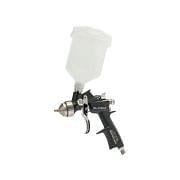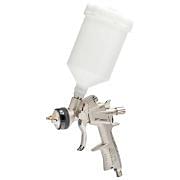Airbrushes
Airbrushes are indispensable tools in machine shops, essential for painting and coating mechanical components. The precision and quality of the work carried out with airbrushes make the difference in the final result, guaranteeing impeccable and durable finishes.
Airbrushes are devices that use compressed air to spray paints, enamels and other coatings on various surfaces. They are particularly useful in machine shops for painting cars, motorbikes and other mechanical components. Their ability to apply coatings evenly and precisely makes them irreplaceable tools for achieving high-quality finishes.
The operating principle of spray guns is based on compressed air passing through a nozzle, which atomises the coating liquid creating a fine mist. This atomisation allows the coating to be applied evenly to surfaces of different shapes and sizes. There are various types of spray guns, including high-pressure and low-pressure guns, each suited to specific applications.
The use of spray guns offers numerous advantages in machine shops. First of all, they enable high-quality finishes to be obtained with considerable time savings compared to traditional painting methods. In addition, they reduce material waste due to their precision in applying the coating.
Car painting airbrushes, for example, are essential for achieving a perfect, even finish, improving the aesthetics and durability of the paint. The best professional spray guns are designed for high performance and long life, even under intense working conditions.
To ensure optimal operation and a long service life, proper maintenance of mechanical spray guns is essential. This includes regular cleaning of the nozzle and tank, inspection of seals and lubrication of moving parts. Proper maintenance prevents clogging and malfunctioning, ensuring excellent spray quality at all times.
High-precision spray guns are ideal for jobs requiring minute details and an impeccable finish. In machine shops, these tools are used for painting small, complex components where precision is crucial. Their ability to control the paint flow with great accuracy makes them particularly popular in the professional field.
The correct use of spray guns in the workshop requires some practice and familiarity with the equipment. It is important to set the air pressure and paint viscosity correctly to achieve the best results. In addition, the working environment must be clean and dust-free to avoid contamination during painting.
Frequently Asked Questions about Airbrushes
What is the difference between a high-pressure and a low-pressure airbrush?
High-pressure airbrushes are used for applications requiring quick and even coverage over large surfaces. Low-pressure airbrushes, on the other hand, offer greater control and precision, ideal for fine details and high-quality work.
How can I avoid clogging in my airbrush?
To avoid clogging, it is important to clean the airbrush after each use, using appropriate solvents to remove paint residue. Also, filtering the paint before use can prevent solid particles from entering the nozzle.
What is the ideal air pressure for airbrush use?
The ideal air pressure varies depending on the type of airbrush and the job to be done. Typically, for high-pressure airbrushes, pressures between 20 and 30 PSI are used, and for low-pressure airbrushes, between 10 and 20 PSI.
Spray guns are essential tools for machine shops, offering precision, efficiency and quality in painting operations. With proper maintenance and use, these devices can transform the way paint jobs are carried out, ensuring professional and long-lasting results.




